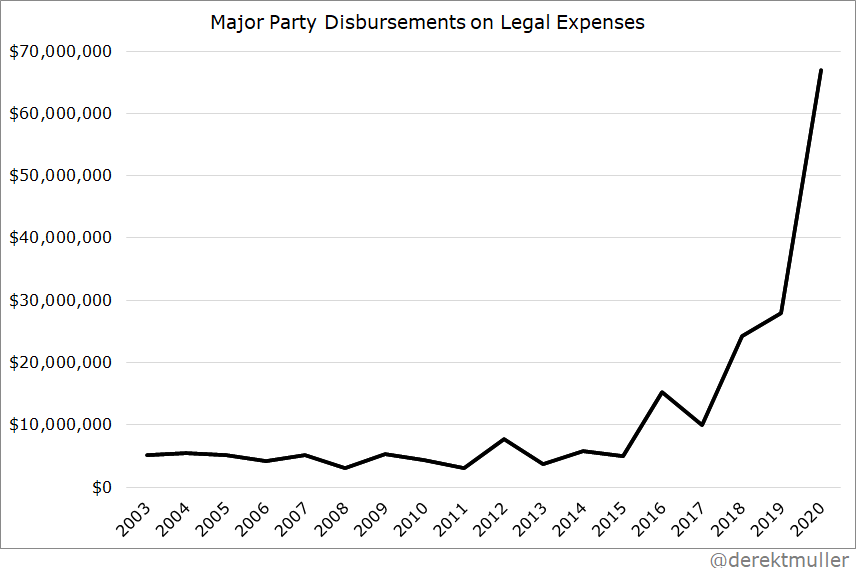Guy-Urïel Charles and Luis Fuentes-Rohwer, have a new piece in the Iowa Law Review. I offered a commentary, here. Just to give you a flavor for the piece is, here’s a brief excerpt from my introduction, which offers a rough summary of their argument:
It feels like a moment. I know I’m supposed to analyze this piece from a purely academic perspective, but first I want to mark the occasion. Guy-Urïel Charles and Luis Fuentes-Rohwer, two of the most astute commentators on the intersection of election law and civil rights, think it’s time to give up on Section 5 of the Voting Rights Act (“VRA”), perhaps it’s even time to give up on the civil-rights paradigm altogether. When I assigned this paper to my class, one of the students said that she realized it’s time for her to start mourning the Voting Rights Act because it’s never coming back.
For me, the mourning process began when Shelby County v. Holder came down. But until I’d read “The Voting Rights Act in Winter: The Death of a Superstatute,” I’d been a naïve cynic (or a cynical naïf). I’d hoped that I wasn’t being hopeful enough. But when the always-wise and ever-optimistic Guy Charles—the academic who insisted in 2006 that the civil-rights community should reject the renewal act and try for better—tells us that something’s over, it’s probably over. When the duo that valiantly tried to lay the groundwork for rebuilding Section 5 tells you it’s time to chart a different course, it’s probably time to chart a different course.
None of this will be easy to hear if you still subscribe to the political consensus that animated the Voting Rights Act, if you believe that Section 5 was the crown jewel of the VRA, if you think that we still need an administrative alternative to costly litigation for race-based voting claims. Now feels like an especially hard time to hear that we must set aside the race-discrimination model given how large Ferguson and Garner loom. Which is why it takes a certain kind of courage to write what Charles and Fuentes-Rohwer have written here. If you think it’s hard to hear these things, just imagine how hard it is to write them, at least for people who haven’t spent their careers playing the studied contrarian.
Academic pieces are strange creatures, and they aren’t well suited for elegies. Yet this feels like one to me. Academics are strange creatures themselves. Perhaps, then, it’s not surprising that an elegy by two scholars would come in the form this one does: the systematic, clear-eyed, and relentless documenting of the death of a superstatute. It feels like the scholarly equivalent of a doctor calling it when the patient’s heart has stopped.
Perhaps because this is an elegy wrapped in a piece of scholarship, some readers will offer the conventional academic critique and say that there are really two articles here. The first half of the Article charts the death of a superstatute, and the second imagines a new future for voting rights.
At first glance, the two subjects seem unrelated. The first half enters into a conversation (carried on mostly by my colleagues at Yale) about what Ernie Young has called “the constitution outside the Constitution” — those sturdy, stable programs and principles that constitute our society even if they are not enshrined in our Constitution’s text. The death of a superstatute is an understudied topic precisely because superstatutes aren’t supposed to die. The second half of the Article, meanwhile, continues a conversation that the field of election law had been having ever since the oral argument in Northwest Austin Municipal District No. 1 v. Holder (“NAMUDNO”), one that is more pragmatically focused on identifying a framework for resolving elections claims. That conversation is not nearly as wide-ranging or theoretically oriented as the one on superstatutes. Election law scholars, after all, are trying to come up with a regulatory scheme at the intersection of what Congress can pass and what the Court can accept, and it may well be a null set. These are different conversations, and it’s no wonder that the two halves of the Article read so differently.
While I have something to say about each part of the Article, I think the two pieces are much more closely related than that. To be sure, the effort to chart the death of a superstatute is interesting standing alone and generates its own cache of insights, as I note below. But this argument serves a larger purpose here: It reminds you how much work it takes to maintain a superstatute in the first place. Those who resist the premise of the second half of the Article—that it’s time to chart a new course—must first grapple with the truths in the first half of the Article. As the authors show, it was a huge lift to get three branches of government to work in conjunction with one another to support Section 5. For those who think that all we need is a fifth vote on the Supreme Court to restore Section 5 to her old glory, Charles and Fuentes-Rohwer remind us just how many times the Court and Congress and the Executive Branch had to bend over backwards not just to keep the old girl alive, but to maintain Section 5 as a vibrant regulatory framework. This analysis will be sobering to those who want to cast Shelby County simply as a 5–4 ruling rather than part of a political sea change. Indeed, the first half of the Article makes clear just how far these tides have receded. While the two halves of the Article are quite different, then, they plainly work in tandem and deepen the authors’ argument along almost every dimension.
